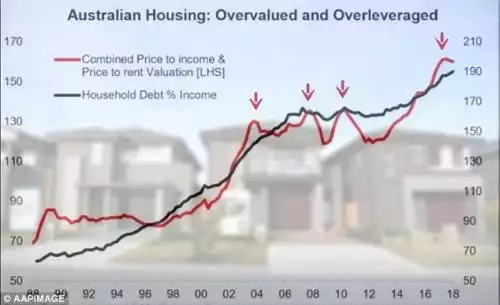Overvalued & Overleveraged
News
|
Posted 17/08/2018
|
9872
The July numbers for Australia’s house prices was released this last week and we saw further falls in the 5 capital city aggregate to 3.34% down for the year, lead by Sydney, now down by over 7%. This spurred an article in the Daily Mail reporting Sydney as one of the world’s most overvalued cities. More alarming however was the reminder of the debt that sits behind this setup.
The article highlights that 30 years ago Australia enjoyed the title of having the lowest household debt-to-income ratio of first world nations to now being ‘top of the pack’. They published the following chart that speaks volumes to the nasty confluence of our housing being overvalued and our household debt at record highs.

The broader implications are clear and we have written at length about this before (most recently here).
AMP Capital chief economist Dr Shane Oliver said “Australian house prices were likely to fall by double digit percentages, and by about 15 per cent in Sydney, in coming years but not enough to get household debt to income rates back to the levels of the late 1980s.
'The best possible scenario for young people is that prices come off say another 10 per cent and then we spend many years where prices just go sideways and wages eventually catch up,' he said.
Those wishing for a dramatic plunge in housing prices should be mindful about what that could mean for them personally.
'I know a lot of young people would say, "Well, I want prices to crash, 30 per cent collapse, bring it on",' Dr Oliver said.
'Trouble is, they probably won't have a job if that occurs.'”
Such is our love affair with housing, a generation’s belief that ‘property never goes down’, debt funded “instant gratification”, and complete disregard for the consequences of over-borrowing that we have seen our household debt as a percentage of household income after tax rocket from just 40% in 1970, to 60% in 1988 right up to the current 189%. The Economist recently stated that Sydney house prices were still 50% overvalued compared to income, one of the very worst in the world.
Whilst many of these borrowers take exuberant comfort in the RBA indicating we won’t see an interest rate hike in this country until 2019, they forget our banks are now funding their mortgage with a large portion of overseas debt where interest rates are on the move, and the small issue of their mortgage being for 30 years not 2. They shouldn’t think for a minute the banks will ‘wear’ that cost just because the RBA holds it’s rates.